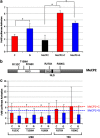Transcriptional regulation of the MET receptor tyrosine kinase gene by MeCP2 and sex-specific expression in autism and Rett syndrome
- PMID: 24150225
- PMCID: PMC3818007
- DOI: 10.1038/tp.2013.91
Transcriptional regulation of the MET receptor tyrosine kinase gene by MeCP2 and sex-specific expression in autism and Rett syndrome
Abstract
Single nucleotide variants (SNV) in the gene encoding the MET receptor tyrosine kinase have been associated with an increased risk for autism spectrum disorders (ASD). The MET promoter SNV rs1858830 C 'low activity' allele is enriched in ASD, associated with reduced protein expression, and impacts functional and structural circuit connectivity in humans. To gain insight into the transcriptional regulation of MET on ASD-risk etiology, we examined an interaction between the methyl CpG-binding protein 2 (MeCP2) and the MET 5' promoter region. Mutations in MeCP2 cause Rett syndrome (RTT), a predominantly female neurodevelopmental disorder sharing some ASD clinical symptoms. MeCP2 binds to a region of the MET promoter containing the ASD-risk SNV, and displays rs1858830 genotype-specific binding in human neural progenitor cells derived from the olfactory neuroepithelium. MeCP2 binding enhances MET expression in the presence of the rs1858830 C allele, but MET transcription is attenuated by RTT-specific mutations in MeCP2. In the postmortem temporal cortex, a region normally enriched in MET, gene expression is reduced dramatically in females with RTT, although not due to enrichment of the rs1858830 C 'low activity' allele. We newly identified a sex-based reduction in MET expression, with male ASD cases, but not female ASD cases compared with sex-matched controls. The experimental data reveal a prominent allele-specific regulation of MET transcription by MeCP2. The mechanisms underlying the pronounced reduction of MET in ASD and RTT temporal cortex are distinct and likely related to factors unique to each disorder, including a noted sex bias.
Figures




Similar articles
-
Reciprocal co-regulation of EGR2 and MECP2 is disrupted in Rett syndrome and autism.Hum Mol Genet. 2009 Feb 1;18(3):525-34. doi: 10.1093/hmg/ddn380. Epub 2008 Nov 10. Hum Mol Genet. 2009. PMID: 19000991 Free PMC article.
-
The relationship of Rett syndrome and MECP2 disorders to autism.Dialogues Clin Neurosci. 2012 Sep;14(3):253-62. doi: 10.31887/DCNS.2012.14.3/jneul. Dialogues Clin Neurosci. 2012. PMID: 23226951 Free PMC article. Review.
-
MeCP2+/- mouse model of RTT reproduces auditory phenotypes associated with Rett syndrome and replicate select EEG endophenotypes of autism spectrum disorder.Neurobiol Dis. 2012 Apr;46(1):88-92. doi: 10.1016/j.nbd.2011.12.048. Epub 2012 Jan 9. Neurobiol Dis. 2012. PMID: 22249109 Free PMC article.
-
Reduced MeCP2 expression is frequent in autism frontal cortex and correlates with aberrant MECP2 promoter methylation.Epigenetics. 2006 Oct-Dec;1(4):e1-11. doi: 10.4161/epi.1.4.3514. Epigenetics. 2006. PMID: 17486179 Free PMC article.
-
Evolving role of MeCP2 in Rett syndrome and autism.Epigenomics. 2009 Oct;1(1):119-30. doi: 10.2217/epi.09.13. Epigenomics. 2009. PMID: 20473347 Free PMC article. Review.
Cited by
-
Receptor Tyrosine Kinase MET Interactome and Neurodevelopmental Disorder Partners at the Developing Synapse.Biol Psychiatry. 2016 Dec 15;80(12):933-942. doi: 10.1016/j.biopsych.2016.02.022. Epub 2016 Feb 26. Biol Psychiatry. 2016. PMID: 27086544 Free PMC article.
-
Suppression of Akt-mTOR pathway rescued the social behavior in Cntnap2-deficient mice.Sci Rep. 2019 Feb 28;9(1):3041. doi: 10.1038/s41598-019-39434-5. Sci Rep. 2019. PMID: 30816216 Free PMC article.
-
Hepatocyte Growth Factor Modulates MET Receptor Tyrosine Kinase and β-Catenin Functional Interactions to Enhance Synapse Formation.eNeuro. 2016 Aug 29;3(4):ENEURO.0074-16.2016. doi: 10.1523/ENEURO.0074-16.2016. eCollection 2016 Jul-Aug. eNeuro. 2016. PMID: 27595133 Free PMC article.
-
Cigarette smoke enhances oncogene addiction to c-MET and desensitizes EGFR-expressing non-small cell lung cancer to EGFR TKIs.Mol Oncol. 2018 May;12(5):705-723. doi: 10.1002/1878-0261.12193. Epub 2018 Apr 14. Mol Oncol. 2018. PMID: 29570930 Free PMC article.
-
Disrupted Timing of MET Signaling Derails the Developmental Maturation of Cortical Circuits and Leads to Altered Behavior in Mice.Cereb Cortex. 2022 Apr 5;32(8):1769-1786. doi: 10.1093/cercor/bhab323. Cereb Cortex. 2022. PMID: 34470051 Free PMC article.
References
Publication types
MeSH terms
Substances
Grants and funding
LinkOut - more resources
Full Text Sources
Other Literature Sources
Medical
Molecular Biology Databases
Miscellaneous

